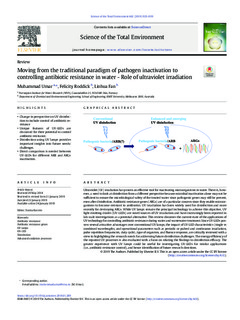| dc.contributor.author | Umar, Muhammad | |
| dc.contributor.author | Roddick, Felicity | |
| dc.contributor.author | Fan, Linhua | |
| dc.date.accessioned | 2019-10-14T15:29:01Z | |
| dc.date.available | 2019-10-14T15:29:01Z | |
| dc.date.created | 2019-03-19T15:16:35Z | |
| dc.date.issued | 2019 | |
| dc.identifier.citation | Science of the Total Environment. 2019, 662, 923-939. | nb_NO |
| dc.identifier.issn | 0048-9697 | |
| dc.identifier.uri | http://hdl.handle.net/11250/2622079 | |
| dc.description | | nb_NO |
| dc.description.abstract | Ultraviolet (UV) irradiation has proven an effective tool for inactivating microorganisms in water. There is, however, a need to look at disinfection from a different perspective because microbial inactivation alone may not be sufficient to ensure the microbiological safety of the treated water since pathogenic genes may still be present, even after disinfection. Antibiotic resistance genes (ARGs) are of a particular concern since they enable microorganisms to become resistant to antibiotics. UV irradiation has been widely used for disinfection and more recently for destroying ARGs. While UV lamps remain the principal technology to achieve this objective, UV light emitting diodes (UV-LEDs) are novel sources of UV irradiation and have increasingly been reported in lab-scale investigations as a potential alternative. This review discusses the current state of the applications of UV technology for controlling antibiotic resistance during water and wastewater treatment. Since UV-LEDs possess several attractive advantages over conventional UV lamps, the impact of UV-LED characteristics (single vs combined wavelengths, and operational parameters such as periodic or pulsed and continuous irradiation, pulse repetition frequencies, duty cycle), type of organism, and fluence response, are critically reviewed with a view to highlighting the research needs for addressing future disinfection challenges. The energy efficiency of the reported UV processes is also evaluated with a focus on relating the findings to disinfection efficacy. The greater experience with UV lamps could be useful for investigating UV-LEDs for similar applications (i.e., antibiotic resistance control), and hence identification of future research directions. | nb_NO |
| dc.language.iso | eng | nb_NO |
| dc.publisher | Elsevier | nb_NO |
| dc.rights | Med mindre annet er angitt, så er denne innførselen lisensiert som Navngivelse 4.0 Internasjonal | * |
| dc.rights.uri | https://creativecommons.org/licenses/by/4.0/ | * |
| dc.title | Moving from the traditional paradigm of pathogen inactivation to controlling antibiotic resistance in water - Role of ultraviolet irradiation | nb_NO |
| dc.type | Journal article | nb_NO |
| dc.type | Peer reviewed | nb_NO |
| dc.description.version | publishedVersion | nb_NO |
| dc.source.pagenumber | 923-939 | nb_NO |
| dc.source.volume | 662 | nb_NO |
| dc.source.journal | Science of the Total Environment | nb_NO |
| dc.identifier.doi | 10.1016/j.scitotenv.2019.01.289 | |
| dc.identifier.cristin | 1686003 | |
| cristin.unitcode | 7464,20,16,0 | |
| cristin.unitname | Systemer og teknologi | |
| cristin.ispublished | true | |
| cristin.fulltext | | |
| cristin.qualitycode | 2 | |

